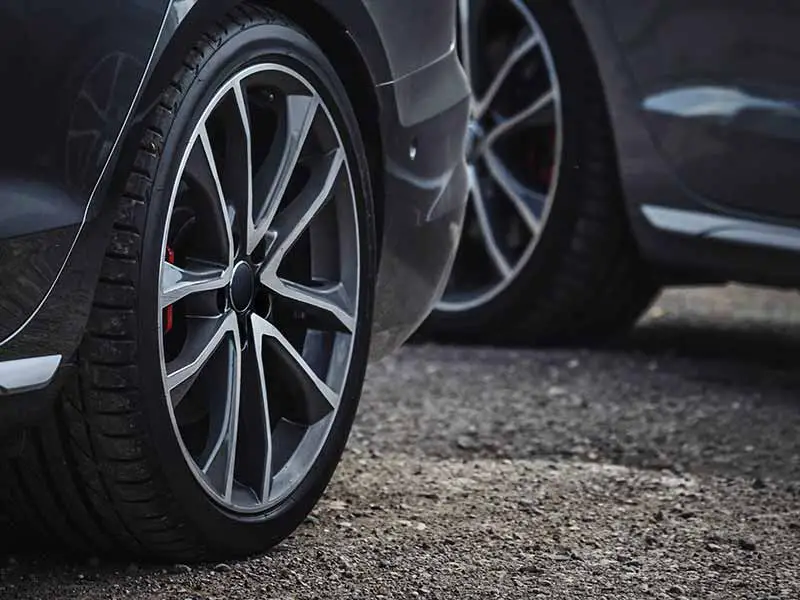Tire rotation patterns are usually determined by which axle tires wear more quickly. This is usually the axle that drives the vehicle forward. Rear drive cars and trucks tend to wear the rear tires down more quickly than the front tires.
Rotating tires is important for maintaining your tire warranty and getting the most out of your tires. But the right pattern will ensure the best results.
Rear Wheel Drive Tire Rotation
There are two acceptable rotation patterns for rear wheel drive vehicles. The rearward cross and X-pattern. The rearward cross is the more preferable method since it better distributes the tires around the car or truck over time.
But there are always exceptions to the rule. Directional tires and staggered wheels have unique requirements that force you to use different rotation patterns.
Let’s dive in to all of the details of the different tire rotation patterns for rear drive cars and trucks.

Rear Wheel Drive Rotation Patterns
Rear drive vehicles put much more strain on the tires at the rear, causing them to wear down much more quickly than the front tires.
Each tire on any car or truck comes into contact with the road surface at different angles. Most people will assume that the tires sit flat on the pavement and don’t lean in any direction.
The various suspension geometry angles are designed to improve handling and stability and make a substantial difference in how well your vehicle performs. But this comes at the cost of even tire wear.
Rearward Cross Pattern
The rearward cross pattern is optimized to get the most benefit out of rotating RWD tires. With the rearward cross, the rear tires move to the front and across to the opposite sides of the vehicle. The front tires move to the rear and remain on the same sides.
X-Pattern
The X-pattern moves the rear tires to the front and across to the opposite sides of the vehicle and the front tires move to the rear and also move to the opposite sides.
Best Tire Rotation Pattern For RWD
The rearward cross is considered the best tire rotation pattern for rear drive cars and trucks. It’s designed to prioritize evening out the wear of the rear tires and eventually distribute each tire to every position around the vehicle.
The X-pattern is acceptable but the tires won’t work their way around the car or truck. They will simply criss cross to the same two positions with each tire rotation.
How To Rotate Directional Tires On RWD
Directional tires can only spin in one direction. The sidewall of directional tires will have an arrow indicating how the tire is required to spin so that it will work as designed.
This means that when the technician mounts a tire onto a wheel he or she will need to make sure that two wheels have the arrow pointing in one direction and the other two wheels will need to have the arrow pointing in the other.
Once the tires are mounted onto the wheels they can only be used on one side of the car or truck, otherwise they will spin in the wrong direction.
Occasionally, asymmetrical tires are confused with directional tires. Asymmetrical tires have an indicator on the sidewall stating which sidewall faces outward but these tires can spin in either direction.
How this affects tire rotation is that directional tires can only be rotated front to rear. You can’t have the tires cross from side to side or the tire tread will not be spinning in the correct direction and the tires will not grip as designed. This can be particularly dangerous in wet weather.
Front To Rear
Front to rear tire rotation is exactly as it sounds. The front tires rotate to the rear position and the rear tires rotate to the front.
How To Rotate Staggered Wheels On RWD
Staggered wheels are when the size of the wheels and tires are different on the front axle tires than the rear axle tires and wheels.
This situation is more common with rear drive sports cars. Wider tires have more traction which helps with acceleration. It also helps prevent oversteer which is more of a problem with rear wheel driven vehicles.
Side To Side
Side to side tire rotation is exactly as it sounds. The driver’s side wheels and tires rotate to the passenger side, and passenger side move to the driver’s side. The wheels and tires stay on the same front and rear axles they were on previously.
How To Rotate Tires On RWD With Full Size Matching Spare Tire
If you have a full size spare tire and the wheel matches the other four wheels, you can greatly benefit from including the spare tire into the tire rotation pattern.
Not only will your set of tires last longer, but your spare tire won’t go to waste if not used for normal spare tire duty. Also, by including it with regular tire rotation, the spare will get regularly checked for proper air pressure so that it is far more likely to be ready for use in the event you need it.
Rearward Cross 5-Tire Rotation Pattern
A rearward cross 5-tire rotation is identical to the normal rearward cross pattern with the only exception being that the driver’s side front tire moves to the spare tire location and the spare tire moves to the passenger rear position.
Do Rear Drive Cars Need Tire Rotation?
Every car or truck benefits from regularly rotating tires. All cars and trucks have tire wear patterns that are different at each tire position around the vehicle.
Tire rotation will help the tires last longer by not letting areas of the tire tread go relatively unused while another area gets worn past the point of the tire being usable.
It’s also important to rotate your tires according to the tire manufacturer requirements to maintain your tire mileage warranty. Most tire warranties will require regular tire rotation. If you don’t perform these rotations within the mileage window required they will not honor the warranty if you have a need to make a claim.
When Not To Rotate Your Tires
There are a couple of situations where you actually shouldn’t rotate your tires. These are both true for front wheel drive vehicles, all wheel drive vehicles, and rear drive.
If you have both directional tires and staggered wheels, it will not be possible to rotate your tires and trying to do so could be dangerous. Directional tires can only be rotated front to rear and staggered wheels and tires can only be rotated side to side. If you have both of these situations there are no tire rotation patterns that will allow you to safely rotate your tires.
How Often Should I Rotate RWD Tires?
Tire rotation should be performed at or before the requirement specified by your tire manufacturer to maintain the tire warranty. Refer to the paperwork provided with your tires to find out what that mileage limit is and be sure to rotate your tires before that amount. Also check for other requirements they may list.
Generally, I recommend tire rotation be performed every 5,000 miles. This usually meets or exceeds most tire manufacturer warranty requirements and provides a bit of extra buffer.
It’s smart to combine tire rotations with other maintenance services. Tire rotation services are often provided for free with other vehicle maintenance.
Final Thoughts
The rearward cross is the best rotation pattern for rear wheel drive vehicles. This pattern will ensure that each tire will eventually make its way to each position around the car or truck.
The X-pattern works very well too but the tires won’t wear quite as evenly over time do to only swapping positions with one other tire.
While directional tires and staggered wheel sets can limit rotation patterns, both of these situations come with benefits that are often worth the compromise.
The greatest benefit of regularly rotating your tires comes from maintaining the tire manufacturer’s mileage warranty. Some cars and trucks are harder on a set of tires and will not be able to get the amount of miles out of them that the tire manufacturer guarantees. This is a big win for you because despite this, they will still honor the guarantee as long as you’ve met the requirements.
Resources
Below are some links you may find helpful when learning about tires





